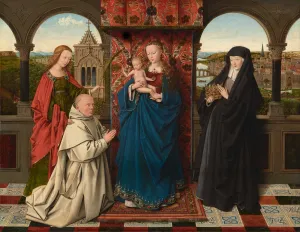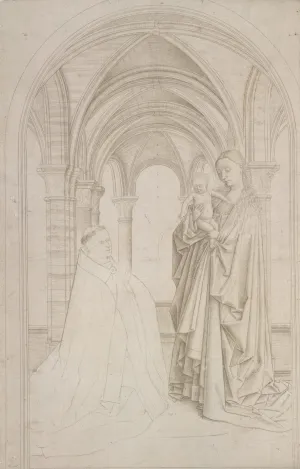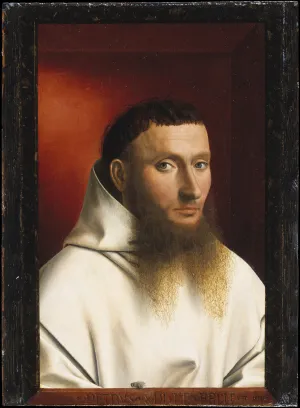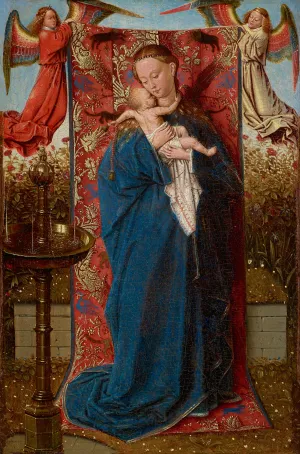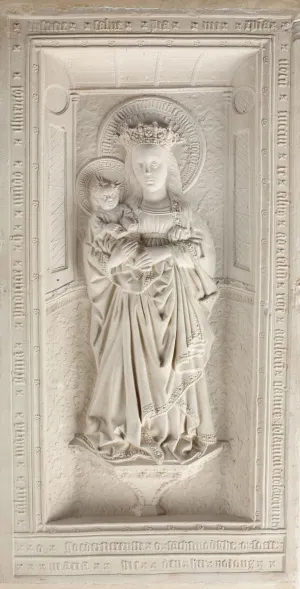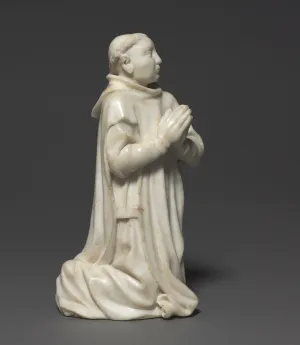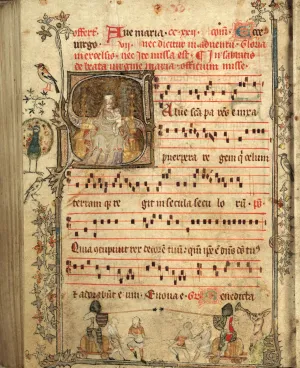Checklist
Jan van Eyck and workshop
The Virgin and Child with St. Barbara, St. Elizabeth, and Jan Vos, ca. 1441–43
Oil on Masonite, transferred from panel
18 5/8 x 24 1/8 in. (47.3 x 61.3 cm)
The Frick Collection
© The Frick Collection
This painting was probably commissioned from Jan van Eyck by the Carthusian monk Jan Vos following the latter’s appointment as prior of the Charterhouse of Bruges (Genadedal) in April 1441. Technical examination suggests that Van Eyck laid out the essential design for the figures and the execution was left to a skilled assistant — possibly because of the master’s death in June of that year. Astonishing in its myriad details, the panel depicts Jan Vos seeking the intercession of the Virgin and Child, under the protection of two female saints.
Petrus Christus
The Virgin and Child with St. Barbara and Jan Vos (Exeter Virgin), ca. 1450
Oil on panel
7 5/8 x 5 1/2 in. (19.5 x 14 cm)
Staatliche Museen zu Berlin Preussischer Kulturbesitz, Gemäldegalerie, Berlin
Photo: Christoph Schmidt
Jan Vos seems to have commissioned this panel from Petrus Christus shortly before leaving Bruges in 1450. Vos probably gave the Frick Virgin to Christus as a model, but the artist also drew inspiration from another late work by Van Eyck, the lost Maelbeke Virgin, the composition of which he recorded in the drawing shown in this exhibition.
Attributed to Petrus Christus, after Jan van Eyck and workshop
The Virgin and Child with a Donor, copy after The Virgin and Child with Canon Nicolas van Maelbeke (Maelbeke Virgin), ca. 1445
Silverpoint on prepared paper
10 15/16 x 7 1/16 in. (27.8 x 18 cm)
The Albertina, Vienna
The Albertina Museum, Vienna
This drawing records the appearance of a lost memorial painted by Jan van Eyck and his workshop in the early 1440s to commemorate the canon Nicolas van Maelbeke. Special care was taken in replicating the Virgin and Child, the deep sculptural folds of the Virgin’s mantle, and the carefully constructed architectural setting, but the landscape background and most of the donor figures were omitted. This selective approach was common in fifteenth-century workshops.
Petrus Christus
Portrait of a Carthusian Lay Brother, 1446
Oil on panel
11 1/2 x 8 1/2 in. (29.2 x 21.6 cm)
The Metropolitan Museum of Art, New York; The Jules Bache Collection, 1949
The Metropolitan Museum of Art, New York
This portrait was painted by Christus during the middle of Jan Vos’s tenure as prior of Genadedal and most likely depicts another of the monastery’s members. The sitter’s lack of tonsure and beard identifies him as a lay brother, that is, someone who had taken a vow but practiced a more relaxed version of Carthusian life. It seems to be the earliest recorded portrait of a cleric in which the sitter is not shown praying. The young man’s confident, outward gaze suggests that the portrait was intended for a secular setting.
Workshop of Jan van Eyck
The Virgin and Child by a Fountain, ca. 1440
Oil on panel
8 3/8 x 6 3/4 in. (21.3 x 17.2 cm)
Private collection
Photo: Michael Bodycomb
This is a fine copy after a work painted by Jan van Eyck in 1439, today in the Museum of Fine Arts, Antwerp. The composition was immensely popular in Bruges, and at Genadedal in particular, until the first decades of the sixteenth century. The figures of the Virgin and Child, along with the oak-leaf motif in the Cloth of Honor behind them, are adapted in the Frick Virgin.
Unknown artist, Utrecht
Relief with the Virgin and Child (The Virgin of Zoeterwoude), 2nd half of 15th century
Pipe clay
16 13/16 x 8 11/16 x 1 in. (42.6 x 22 x 2.5 cm)
Museum Catharijneconvent, Utrecht
Jan Vos also owned a tablet made of clay depicting the Virgin holding Christ in her arms. As with the Frick Virgin, an indulgence of forty days was granted to Vos’s clay tablet in exchange for the recitation of an Ave Maria. Such clay tablets were a typical production of Utrecht, where Jan Vos spent the first and last years of his career. They were made of a local material called pipe clay, which turned white upon heating, and were popular devotional objects in Carthusian communities.
Unknown artist (Burgundy)
Kneeling Carthusian Monks
Late 14th century
Marble
10 1/16 x 5 1/2 x 2 5/8 in. (25.7 x 14.1 x 6.8 cm)
The Cleveland Museum of Art; John L. Severance Fund, Cleveland
© Cleveland Museum of Art
Anticipating the figure of Jan Vos in the Frick Virgin, these two marble statuettes are among the first sculptural representations of Carthusians as kneeling devotees. They wear the white scapular, the order’s distinctive mantle tied at the side by loose straps. In contrast to Jan Vos’s effigy, they do not portray actual individuals but rather embody a paradigm of Carthusian devotion and perpetual prayer. Their exact origin and function remain a mystery, as does the object of their devotion — probably a lost Crucifixion or Virgin.
Adam Dircksz and workshop
François du Puy Prayer-Nut, ca. 1517−21
Boxwood
Diam. 1 7/8 in. (4.7 cm)
Private collection
This prayer-nut is the only surviving boxwood micro-carving associated with the Carthusian order. It exemplifies the variety of devotional objects used by the monks, especially in the order’s upper echelons. Depicted across its two hemispheres is the prior-general of the order, François du Puy, introduced by the order’s founder, St. Bruno, to the Virgin and Child. Du Puy holds a scroll petitioning the Virgin — and the viewer — for remembrance and protection. This imagery replicates that of the Frick Virgin on a miniature scale.
Gradual
14th century
Ink, paint, and gold leaf on parchment
6 5/16 × 4 3/4 in. (16 × 12 cm)
Bibliothèque Municipale, Douai
© Institut de Recherche et d'Histoire des Textes
This songbook is one of the only illustrated manuscripts that survives from Genadedal’s former library. The double page provides the score and lyrics for the introductory chant to the mass of the Virgin, which was celebrated most Saturdays. Appropriately, the Virgin and Child appear enthroned on the historiated “S” initial. The holy figures are heavily abraded from generations of monks touching and kissing the image. The margins are enlivened with carefully observed birds and other drolleries that contrast heavenly music with profane clatter.

